Broadcasting from the depths of the sea: 800 km NEPTUNE channel conducts Internet to the bottom of the ocean
- Transfer

Your home Ethernet cable on your desktop does not have to deal with different inhabitants of the oceans, such as, for example, this starfish.
The Juan de Fuca tectonic plate is today one of the smallest in size on Earth. It is located several hundred kilometers from Oregon, Washington and the coast of British Columbia. However, the lack of size of Juan de Fuca pays off for her sociability. It became home to a unique, high-speed optical cable network, which found its way through the deep bottom of the Pacific Ocean at the end of 2009.
This channel is called NEPTUNE - the North-East Pacific Time-Series Underwater Networked Experiment (Northeast Pacific underwater experimental network without temporary interruptions - approx. Translator) Its length is more than 800 kilometers, which is comparable to the length of 40,000 subway cars linked into one long train.
A team of scientists, researchers and engineers from the non-profit Oceans Network Canada group supports the network, which cost $ 111 million to implement and $ 17 million a year to support. It should be noted here that we are dealing with an unusual underwater cable. Unlike such cables, instead of crossing the entire ocean floor, NEPTUNE returns back to the coast - to the very place from which it begins. And although NEPTUNE is designed to improve the transmission of information across the ocean, it also collects information about it and life on its bottom.
So forget about the Internet of Things: NEPTUNE has connected a whole tectonic platform to the Internet.
The deep sea - the last frontier
Oceanography professor John Delaney of the University of Washington proposed NEPTUNE in the mid-90s, anticipating that the subsequent rapid development of the Internet would have a much broader significance than just connecting home and office computers together. He suggested that “distributed networks of automated sensors in the ocean environment” would continuously monitor the seas, using methods that researchers on ships entering the sea at certain short intervals could hardly imagine or afford.
Returning these days, we will see that the constant support of communication with the seabed is still a considerable achievement. Despite the fact that we have long ago mastered the ability to maintain wireless communications with satellites and spacecraft at a distance of billions of kilometers from us, the depths of the ocean are another, barely opened for development line. To begin with, it is worth noting that there are no wireless communications in the water - everything must be wired, waterproof and protected from risk factors, such as accidentally dropped anchors, corrosion and leaks. In this regard, Juan de Fuca is also a significant threat: about 400 earthquakes occur on the plate every year.
Incredibly, Ocean Networks Canada managed to make the whole system work. Five deep-sea locations all over NEPTUNE serve as a place for a huge number of sensors and instruments: from tsunami recognition systems for seismic surveys to measuring the amount of greenhouse gases in the ocean ecosystem. The deepest of the locations - the sixth one, which lacks funding for continuous observations, is located on the very edge of the Juan de Fuca platform at a depth of 2.4 km below the ocean surface - almost as deep as the Alcatel-Lucent submarines that lay NEPTUNE cables can dive.
Each of the locations now, up to a second, provides valuable information about the health of our oceans and the planet as a whole, using methods that scientists on the surface of the sea can only dream of for only a few weeks of summer. By connecting this network to the Internet, we get the opportunity to watch, relay and analyze this information in real time, around the world. It is an absolute realization of Delaney's vision and one of NEPTUNE's most important tasks.
However, launching NEPTUNE for real-time operation and maintaining it in this state was not an easy task. Based on several years of the project, we can safely say that people have never invented computer networks that would work at such depths.

NEPTUNE Project Scope Map
Laying and starting
Wally is a robot the size of a small refrigerator. He travels along the bottom of the Pacific Ocean. Its cable allows it to move within 70 meters in any direction. Together with benthic flora and fauna, he lives in the zone of geothermal faults, which his operators affectionately nicknamed “Wallyland”. This title clearly reads some hint of an amusement park, unless of course your idea of entertainment is a greenhouse full of bacteria and gas hydrates - a solid formation of iced methane, stable only at a depth of at least a kilometer below sea level. This is the place Wally lived for almost two years.
Wally is not like ordinary robotic underwater crawlers: they usually do not stay under water for such a long time. Even the scientists who manage it do it in the most unusual way - using the remote control, on the Internet, from the other side of the planet. Thanks to NEPTUNE, the crawler is constantly connected to the network, receives power from the shore and is available 24 hours a day, 7 days a week, throughout the year.
Geophysicist Martin Skywerot, who is some kind of liaison between Wally and his operators far in Germany, does not know any other deep-sea crawler that would work in a similar way. Apparently the point here is that companies such as Alcatel-Lucent, as a rule, do not carry out any work in places that Wally and other NEPTUNE devices call their home.
“We wanted to lay the cables in places that are usually avoided when laying where they would never be laid,” recalls Kim Juniper. This marine microbiologist is the scientific director of Ocean Networks Canada, acting as an intermediary between the cable network and scientists from around the world involved in the development of devices that his team uses, such as Wally. From 2004 to 2006, as chief scientist, he worked on the design of the NEPTUNE cable route in close collaboration with Alcatel-Lucent.
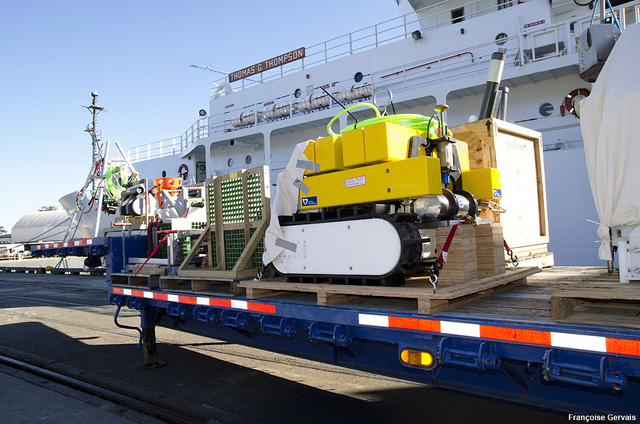
Wally riding on a loading platform
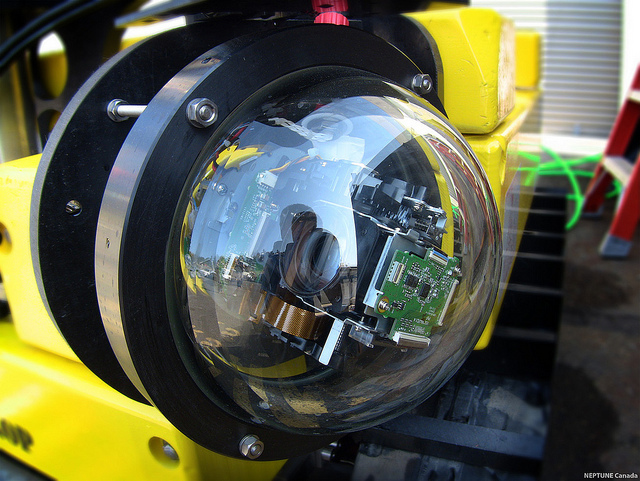
. Wally emergency camera. You can watch what Wally sees online.
In his office, on the damp, tree-lined campus of Victoria University, which Ocean Networks Canada calls his home, Juniper, dressed in a strict shirt with a wide tie, looks more like an office manager than an oceanographer. In order to show me everything clearly, he unfolded a spacious map of the underwater network, which turned out to be much larger than his desk.
The trunk cable carries a tremendous amount of energy - 80 kW, 8 kW of electricity and a channel with a strip of 4 Gbit for each location. In the gap to the edge of the continental shelf, where the depth reaches just over 400 m, the cable is covered with an armored sheath and together with it reaches 3.8 cm in diameter. Using a plow, it burrows into the ocean floor to a depth of at least one meter, eventually reaching the laying depth more than 1.2 km at the maximum distance from the coast.
However, there is always a chance of a break, and it was here that the idea came to the rescue of implementing a network in the form of a loop. Juniper cannot say exactly when this idea came about, however, according to his assumption, the unfriendly environment of the ocean played a role here. The idea is that instead of pulling a long cable into the ocean, leaving its end somewhere in the sea abyss, the cable makes a loop back to the coast station where it starts. And since power and information are circulating in both directions, in the event of any breakdown or malfunction of the equipment, the team can reconfigure NEPTUNE to compensate for the consequences of the malfunction. And even though the network in this state can only work at half its speed, it offers a level of fault tolerance, which most submarine cables do not have.
Further, on each of the six locations along the route of the trunk line - Berkeley Canyon, Endeavor Mountain Range, Folger Canal, Cascadia Bay, Claykvot and Middle Valley slopes, the cable is divided into secondary cables, which are called "branches". These branches are very important, as they help NEPTUNE get to where Alcatel-Lucent does not dare to go - areas where bare rocks, geothermal wells are located on the bottom surface and landslides often occur. Each process leads to a node that is best imagined as a huge underwater network switch that supplies low voltage and provides information communication with the NEPTUNE infrastructure of the second level, consisting of sensors and platforms with devices.
“Alcatel-Lucent has never tried to transfer electricity and connect devices with cables directly underwater,” Juniper says. “Opening their submarine cables to the rest of the world is the last thing they would like to do.”
However, the ability to connect devices to the network and turn them off underwater is key to the entire project. On each of the five working NEPTUNE locations (devices are installed on the sixth, but there is no funding) there are devices called junction boxes. Junction boxes receive low-voltage power from the nodes, connect to their data cables and distribute them further to the instrument platforms (where there are usually a lot of sensors), transfer them to crawlers and devices with high bandwidth requirements, such as hydrophones and cameras. Almost all of this can be connected to the network or disconnected from it directly under water using remotely controlled underwater equipment, which allows the maintenance team to make improvements and install new devices,
The result is a confusion of auxiliary cables, quite similar to the situation with the wires of your home router, only under water and with a total length of almost 90 km.
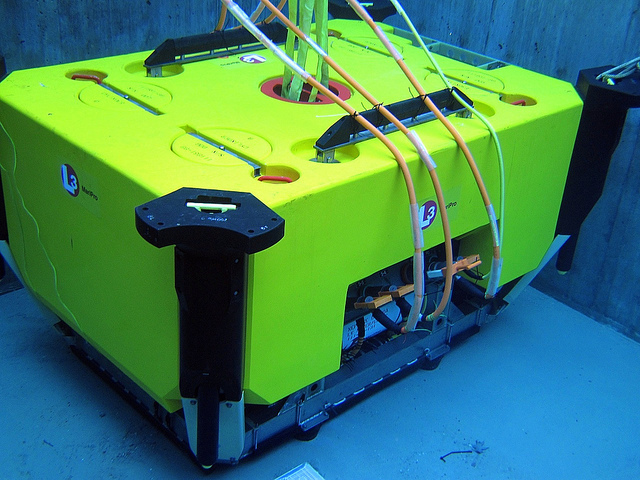
This is how a node looks like in close-up, in a test tank
“We always made Alcatel-Lucent go out of its comfort zone. We ask them about it and they do it for the sake of science. I think, however, that in the future they will use much more conservative solutions when laying telecommunication cables, in particular, they will avoid such volcanic sites, ”Juniper laughs.
Well, the NEPTUNE team, on the contrary, has no choice. All equipment installed outside the nodes, from cables to high-definition cameras, is owned by Ocean Networks Canada. And it is precisely in such inhospitable environments that surveillance is most needed.
Not ordinary maintenance
Canadian border ship John P. Tully is considered a "small" ship. Built in 1984 and named after the famous Canadian oceanographer, it reaches 65 meters in length. However, a walk along the equipment-loaded decks of Tully before sailing in early May is simply stunning. The amount of technical equipment that the team packed into it will dramatically change your idea of the true size of the ship.
A remotely controlled underwater vehicle called Oceanic Explorer, the size of a compact SUV, sits aft, with wires stretched across the deck. Nearby are two cargo containers, inside of which are the control center of the device and the control panel of the satellite communications system. Inside the ship, folded to the ceiling and tied with a rope, there are racks with shooting and broadcasting equipment, and most of the wooden surface is dotted with holes for screws screwed in to secure smaller electronics.
Twice a year, during several weeks of sailing under the name “Installation of the abyss”, carried out for the implementation of technical work, the director of the observational operations Adrian Round calls such vessels his home. A slender bearded Round is well acquainted with life at sea. Now a retired commanding officer of the Canadian Navy ship Algonquin and commander of the Esquimalt base on Vancouver Island near Victoria, he spent 26 years in the Canadian Navy. And for 10 years now he has been working with Ocean Networks Canada.
Given the fact that the primary infrastructure has already been established for a long time, this year's voyages are almost entirely devoted to servicing the secondary network infrastructure: it is necessary to get devices to the surface, clean equipment, calibrate old sensors and lower new ones. Despite the fact that the presence of journalists on this voyage is not provided, the Round is more than willing to take a familiarization tour of Tully, while the last lots of equipment are moved to the deck with the help of hands, cranes and elevators.
NEPTUNE exists thanks to devices and their sensors - electronic tentacles, constantly monitoring, collecting information about water and life on the seabed. As a rule, they are contained in protective structures, in a conversation called simply “banks”. There are banks for power protection and network equipment in NEPTUNE nodes, as well as banks for devices distributed throughout the depth. These structures are filled either with air with a pressure indicator on the surface, or with an oily incompressible liquid that protects the electronics inside.
The irony is that sea water is both an assistant and an obstacle: banks are designed to not only use the features of sea water for their own purposes, but also to resist its negative influence. Despite the fact that the entire network is grounded to sea water, and the ocean is also a good conductor of heat, sometimes electricity behaves in relation to water differently from what NEPTUNE engineers intended. When the voltage does not go out of the device as it should, a short circuit to the seawater can occur. The network is of course designed with a certain margin of safety in case of such leaks, but nothing more. If you do not isolate or turn off the devices in time, a short circuit can burn holes in the walls of structures under pressure, making the equipment vulnerable to the sea.
There are other cases where corrosion corrodes the material. “Everyone thinks, 'Oh, well, just make everything stainless steel!' However, if you leave stainless steel next to the surface covered with hydrothermal cracks, after a few months there will be nothing left from it, explains Round, “Therefore, we use titanium instead of stainless steel.” Well, if we don’t fall below 1000 m, we can safely use plastic covers. ”
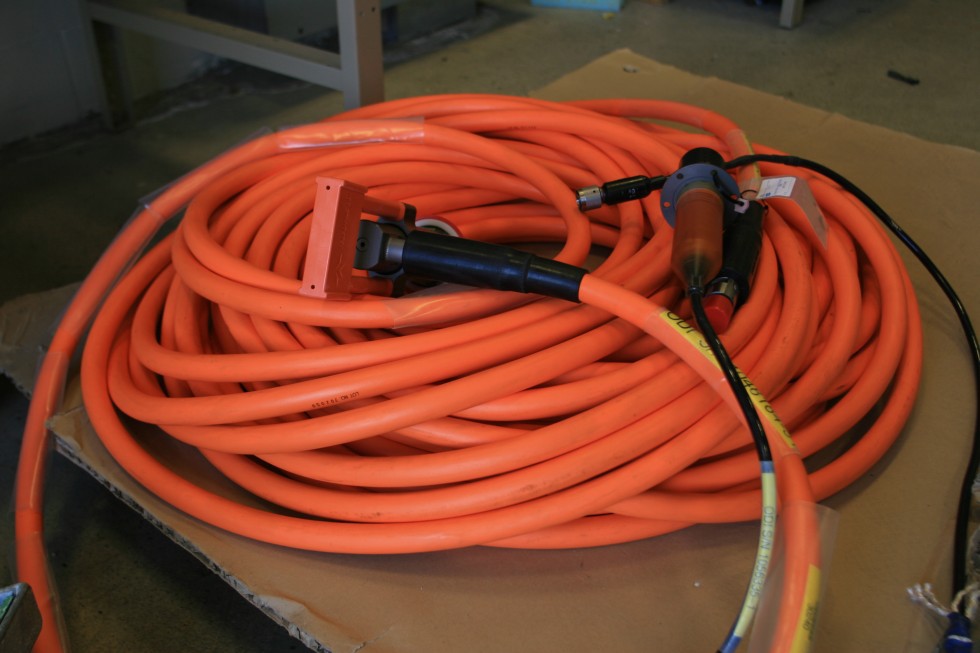
The first such waterproof Ethernet cables that NEPTUNE uses were invented by oil and gas companies.
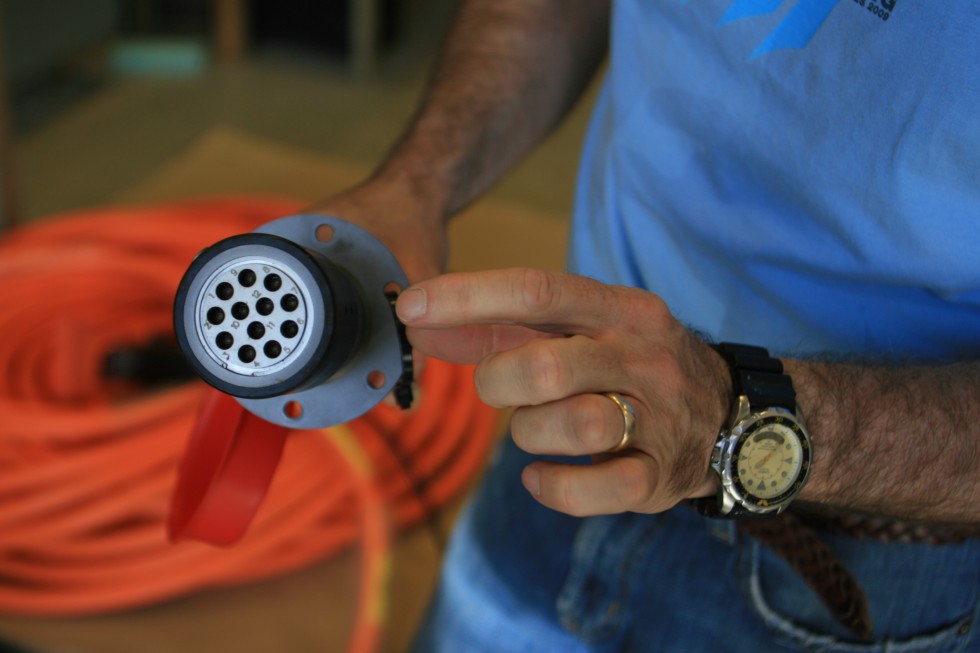
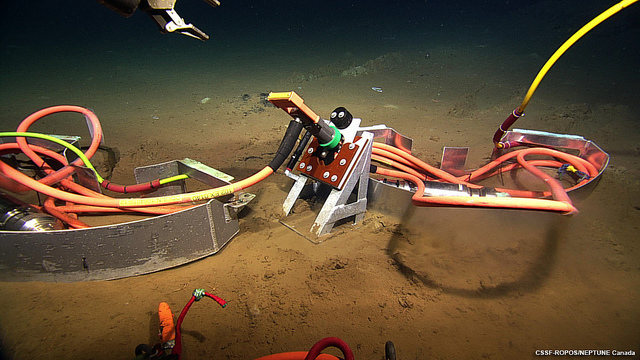
An example of connecting cables
Most of these metal and plastic products were made by Round with their team on their own at the Marine Technology Center nearby. Much was done for the first time and it was not always possible to find prefabricated components, but the cables that connect the devices, junction boxes and NEPTUNE units were actually invented before by the oil and gas industry, and therefore were available for purchase. At the end of the large rubber cable that the Round holds in its hands there is a connector resembling a fire hose, but with gold-plated contacts inside it, arranged in the form of concentric circles.
Before they are connected electrically below at a depth, these gold-plated contacts go through what Round describes as oil baths and water removal, because when “there is no salt water, there is no problem”. The result is the same as the inclusion of an Ethernet cable in the rear panel of your router, with the only exception that, in the case of Adrien, all the work is performed by the operator of the underwater remote control on board Tally who controls the arm of the robot.
The sleeves are filled with silicone oil - an incompressible fluid, which eliminates the possibility that the cable may burst at lower depths. The round would really not want this, because these cables are not cheap. A single pair of connecting copper Ethernet connectors can cost $ 25,000, and this amount doubles if the network needs an extension of the fiber optic cables and new connectors that are required to connect to instrument platforms and junction boxes in case the distance between them exceeds 70 m. Some of these satellite sites operate at a distance of several kilometers. To save money, where possible, NEPTUNE uses dry pairs of connectors. They cost only $ 2500 per pair and are made of titanium, which is preferable for a depth of more than 400 m. The disadvantage in their use is
However, Round understands that they will never be able to eliminate all risks, especially unforeseen ones. Last year, the boat demolished the roof of a vertical profiler - a device that moves with a cable from the seabed to the surface, collecting information about the water column at various depths. Crawler Wally, once, for several troubling weeks, was stuck in a layer of mud. And in the first year of operation of the network, one of the nodes was covered with sand in the relative shallow water of the Volgaire canal, as a result of which it was supposedly overheated, since an autopsy showed the molten electronics inside.
Network cables and connectors remain NEPTUNE's most important and weakest link. As if emphasizing this fact, Round picks up an underwater connector, wrapped in a thick, cloth-like material designed to be insulated from high temperature.
“Geothermal faults may open. This happens by chance. Therefore, we can put it on the ground, everything will be fine, and then, suddenly, the device stops working. We are coming back next year to find out that the gap occurred right below it, melting the plastic, ”says Round, with a grin assuming that it was a rewarding experience.
“There are risks that you are trying to reduce the impact of, and there are those that will have to be accepted,” says Round, “And then, you understand that accepting these risks was a bad decision, and next year you will find a way to eliminate them.”
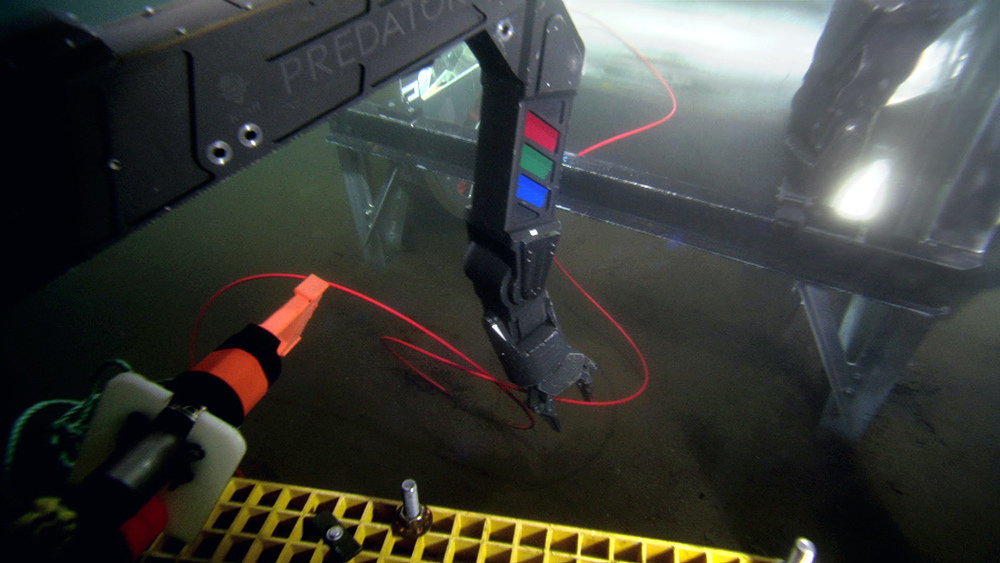
Remotely Operated Platform for Ocean Sciences (ROPOS, a remotely controlled platform for ocean research - approx. Translator ) is a world-class underwater vehicle that can operate at a depth of up to 5000 m. In this photo, he pulls a free cable from his cable management system.
No problem, it's just data
In cases where something goes wrong, NEPTUNE is very similar to any other computer network. Sometimes you just need to turn everything off and on again. Benoit Piren is a man who pushes a switch.
We will return to the University of Victoria, where the assistant director of digital infrastructure faces the matrix of monitors, which occupies most of the wall. In fact, this impressive room is just a reception room, while most screens are displayed in the offices and conference rooms of the building. On one of the displays broadcasting a video from Folger’s reef, underwater vegetation slowly sways at the edge of the screen. On the other, the green, yellow and red indicators show the status of the NEPTUNE sensors, and also show whether the data is being received and correctly recorded.
Establishing communication between the shore and the system proved to be no less difficult than laying the main cables and secondary infrastructure of NEPTUNE. Fortunately, Piren knows something about managing huge scientific computer systems. A tall Belgian computer scientist spent 18 years at the European Southern Observatory, managing systems for managing and archiving data, including those related to the Hubble telescope project.
Until recently, "The largest ships that oceanographers used were ships," Piren jokes, "But scientists have never had an observatory of this level."
Pyrene and his five-man team spent nearly ten years writing software that helped the NEPTUNE sensors "talk." Their work consists in solving two problems: the first is monitoring the network status, similar to how system administrators do it, the second is monitoring that the information sent by sensors is correct and accurate.
On the network, there are approximately 130 devices, divided into 70 - 80 different categories: from high-resolution cameras to chemical sensors and hydrophones, each of which has many sensors that provide different information. Hydrophones and camcorders transmit audio and video data in real time, while other instruments can only transmit one value every second. Catchers of sedimentary rock, for example, do not transmit any information whatsoever, instead collecting physical samples on a schedule every second week.
Almost all NEPTUNE related activities are carried out through sophisticated information management software - Oceans 2.0, which also acts as an interface. It displays each sensor, instrument and junction box connected to all NEPTUNE nodes. Here you can find out information about the general condition of the network, carry out diagnostics or restart problematic devices. Instead of using intelligent technology in the devices themselves, the “smart” component of the network is entirely concentrated in this software.
“We are ready to check devices on a regular basis, twice a year, in weather favorable for swimming,” says Piren, “However, we wanted to make the core of the entire infrastructure as durable as possible, because we don’t want to go down under the water, because the repair will be too expensive. ”The physical elements of the network were purposefully made very simple. The switches inside the nodes and junction boxes are only occupied with sending information back to shore, practically without performing any more complex functions.
Onshore, information from each NEPTUNE instrument and sensor is converted to conventional formats for later archiving and displaying online. Each measurement and indication is accompanied by time stamps, since it is not easy to synchronize the internal clock of each individual device with the rest of the network. Further, the information is processed and placed in a queue for analysis, on the basis of which the system makes a decision on how and where to display and save the results. There are also scripts that check the information for authenticity, identifying instrument malfunctions and whether the received data falls into a possible range of values. There is even information about the devices and sensors themselves - metadata that helps specialists understand the circumstances in which this or that information was collected. To here, for example,
Piren says his team estimates that over 300 million operations are performed daily on data collected by NEPTUNE and other smaller Ocean Networks Canada observatories, resulting in 250 GB of compressed and stored data. Most of them are uncompressed audio recordings of many network hydrophones. All this is stored and archived in the building of the University of Victoria, without the use of cloud technology. After saving, data is backed up to the University of Saskatchewan through a dedicated fiber-optic channel. Since 2009, 250 TB of data has been archived in this way.
In general, the system behaves incredibly stable and this is a considerable achievement, given that we are talking about a high-speed Internet network that works deep under water. Ocean Networks Canada and NEPTUNE sensors are typically aware of potential downtimes in advance. Of course, there can be no question of the stability of the level of commercial data centers. There are also no 99% guaranteed lifetimes. Sometimes a team needs to turn off the system for maintenance and repair, sometimes devices can malfunction or fail.
But Benoit is always ready to knock on wood. Until today, the trunk cable has never failed, and he hopes that this will never happen. This is the only thing that cannot be turned off and on so easily.
Coming soon: the sea will be closer to you
NEPTUNE is one of the world's first underwater cable observatories. Still the largest, today it is one of three such systems located in Canada and managed by Ocean Networks Canada from the University of Victoria campus on the island of Vancouver. The 50-kilometer coastal observatory, under the name VENUS, has been operating since 2006, located between Vancouver Island and the coast of British Columbia. At the end of 2012, a third observatory for the study of Arctic waters and ice was launched in Cambridge Bay.
This fall, two hundred kilometers south of NEPTUNE, it is planned to launch a smaller cable system, called Regional Scale Nodes (RSN, regional nodes - approx. Translator) In the future, it is planned to connect RSN with NEPTUNE, creating a huge international cable network covering the entire Juan de Fuca platform. RSN is overseen by the Institute of Oceanography, led by the University of Washington Oceanographer John Delaney, the first person to predict the emergence of underwater automated sensor systems.
However, today such networks are no longer someone’s idle dreams. Right at this very minute, you can connect to the online broadcast from the bottom of the ocean. In places like Berkeley Canyon, which is a continuation of the continental shelf, organisms live under extremely high pressure, without natural light. Underwater microphones and hydrophones on the Volgaire Canal monitor the effect that marine trawling often has on trawling in this area. At the northern end of the plate, in the open ocean, is the Endeavor mountain range, in which, at a depth of 2 km, there is a hot spot of hydrothermal activity with a constantly forming young earth's crust. At this point, it is possible to observe deep-sea faults, as well as collect and analyze samples from them in real time. Scientists are only now beginning to understand
You can often hear us say with some contempt that knowing so little about our own world, we are nonetheless fascinated by those that lie beyond it. But we can always object that only barely discovered, ghostly and neon-illuminated worlds lying at a depth of kilometers below us look as alien as things that we imagine about space. And finally, we turned on automation, crawlers, cameras and sensors to explore the depths of our own planet. Today we can safely say that the ocean has never been so accessible to people around the world and have never been watched so consistently, every minute.
And now, these days, when you look into the abyss, the abyss, in response, looks at you, in high resolution, real time, accessible through the web browser of your phone.
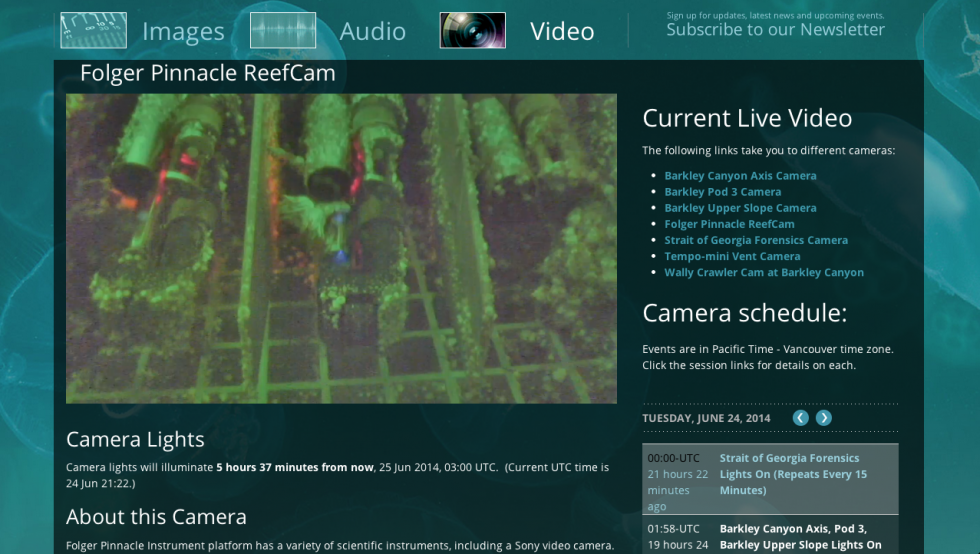
A strange and bewitching video is available here ...

... and the audio is here .
